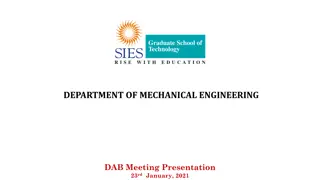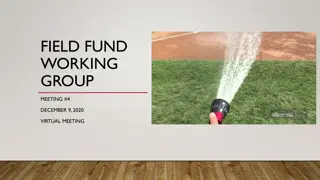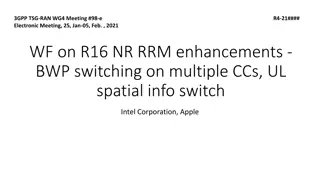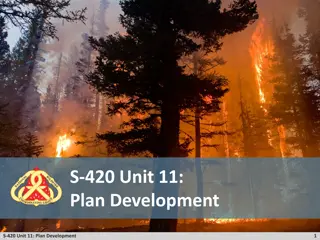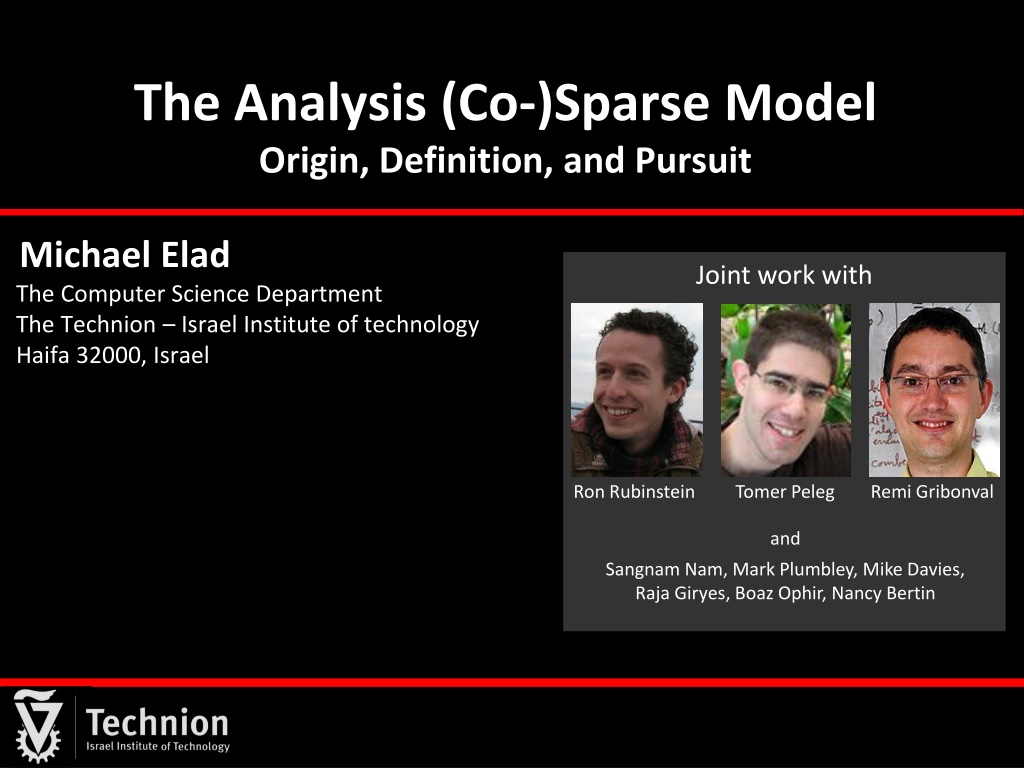
Origin and Pursuit of the Analysis Co-Sparse Model
Explore the development and significance of the analysis (co-)sparse model in signal modeling, highlighting its distinction from the synthesis model. Learn about the potential of this approach for dictionary learning and beyond.
Download Presentation

Please find below an Image/Link to download the presentation.
The content on the website is provided AS IS for your information and personal use only. It may not be sold, licensed, or shared on other websites without obtaining consent from the author. If you encounter any issues during the download, it is possible that the publisher has removed the file from their server.
You are allowed to download the files provided on this website for personal or commercial use, subject to the condition that they are used lawfully. All files are the property of their respective owners.
The content on the website is provided AS IS for your information and personal use only. It may not be sold, licensed, or shared on other websites without obtaining consent from the author.
E N D
Presentation Transcript
The Analysis (Co-)Sparse Model Origin, Definition, and Pursuit Michael Elad The Computer Science Department The Technion Israel Institute of technology Haifa 32000, Israel Joint work with Ron Rubinstein Tomer Peleg Remi Gribonval and Sangnam Nam, Mark Plumbley, Mike Davies, Raja Giryes, Boaz Ophir, Nancy Bertin
Practicing Sparsity in Signal Modeling Sparsity and Redundancy can be Practiced in two different ways Analysis Synthesis The attention to sparsity-based models has been given mostly to the synthesis option, leaving the analysis almost untouched. For a long-while these two options were confused, even considered to be (near)- equivalent. Well now (2014!) we (think that we) know better !! The two are VERY DIFFERENT The Analysis (Co-)Sparse Model: Definition, Pursuit, Dictionary-Learning and Beyond By: Michael Elad 2
This Talk is About the Analysis Model Part I Recalling the Sparsity-Based Synthesis Model Part II Analysis Model Source of Confusion Part III Analysis Model a New Point of View The co-sparse analysis model is a very appealing alternative to the synthesis model, with a great potential for leading us to a new era in signal modeling. The message: The Analysis (Co-)Sparse Model: Definition, Pursuit, Dictionary-Learning and Beyond By: Michael Elad 3
Part I - Background Recalling the Synthesis Sparse Model The Analysis (Co-)Sparse Model: Definition, Pursuit, Dictionary-Learning and Beyond By: Michael Elad 4
The Sparsity-Based Synthesis Model We assume the existence of a synthesis dictionary D IR d n whose columns are the atom signals. Signals are modeled as sparselinear combinations of the dictionary atoms: x = D D We seek a sparsity of , meaning that it is assumed to contain mostly zeros. This model is typically referred to as the synthesissparse and redundant representation model for signals. This model became very popular and very successful in the past decade. x D = The Analysis (Co-)Sparse Model: Definition, Pursuit, Dictionary-Learning and Beyond By: Michael Elad 5
The Synthesis Model Basics n The synthesis representation is expected to be sparse: = 0 k d = d Adopting a synthesis point of view: Dictionary Draw the support T (with k non-zeroes) at random; x D Choose the non-zero coefficients randomly (e.g. iid Gaussians); and ? = ??2 Multiply by D to get the synthesis signal. Such synthesis signals belong to a Union-of-Subspaces (UoS): = T k n = T x span D D x where T T This union contains subspaces, each of dimension k. k The Analysis (Co-)Sparse Model: Definition, Pursuit, Dictionary-Learning and Beyond By: Michael Elad 6
The Synthesis Model Pursuit Fundamental problem: Given the noisy measurements, = + = + y x v I 2 D v, v~ N 0, recover the clean signal x This is a denoising task. = 2 D = = D This can be posed as: x ArgMin y s.t. k 0 2 While this is a (NP-) hard problem, its approximated solution can be obtained by Use L1 instead of L0 (Basis-Pursuit) Greedy methods (MP, OMP, LS-OMP) Pursuit Algorithms Hybrid methods (IHT, SP, CoSaMP). Theoretical studies provide various guarantees for the success of these techniques, typically depending on k and properties of D. The Analysis (Co-)Sparse Model: Definition, Pursuit, Dictionary-Learning and Beyond By: Michael Elad 7
Part II Analysis? Source of Confusion M. Elad, P. Milanfar, and R. Rubinstein, "Analysis Versus Synthesis in Signal Priors", Inverse Problems. Vol. 23, no. 3, pages 947-968, June 2007. The Analysis (Co-)Sparse Model: Definition, Pursuit, Dictionary-Learning and Beyond By: Michael Elad 8
Synthesis and Analysis Denoising p Min s.t. D y p 2 Synthesis denoising p Min x s.t. x y p 2 x Analysis Alternative These two formulations serve the signal denoising problem, and both are used frequently and interchangeably with D= The Analysis (Co-)Sparse Model: Definition, Pursuit, Dictionary-Learning and Beyond By: Michael Elad 9
Case 1: D is square and invertible Analysis Synthesis p p Min x s.t. x y Min s.t. D y p p 2 2 x The Two are = D Exactly Equivalent Define x = 1 Define D = 1 and thus D x p 1 Min D x s.t. x y 2 p x The Analysis (Co-)Sparse Model: Definition, Pursuit, Dictionary-Learning and Beyond By: Michael Elad 10
An example for a square and invertible D convolves the input signal by [+1,-1], and the last row is simply en A sparse x implies that the signal contains only few jumps and it is mostly constant. In synthesis terms, such a signal can be composed of few step functions. D is known as the heavy-side basis, containing the possible step functions The Analysis (Co-)Sparse Model: Definition, Pursuit, Dictionary-Learning and Beyond By: Michael Elad 11
Case 2: Redundant D and D Analysis Synthesis = x p p Min x s.t. x y Min s.t. x D y = T T p p 2 2 x ( ) 1 = = T T x Exact Equivalence again ? = Define x = Define D = and thus x p Min s.t. y p 2 The Analysis (Co-)Sparse Model: Definition, Pursuit, Dictionary-Learning and Beyond By: Michael Elad 12
Not Really ! = x We shouldrequire x = = = T T x ( ) 1 = = T T x The vector defined by = x must be spanned by the columns of . Thus, what we got is the following analysis- equivalent formulation D = p = Min s.t. y & x p 2 which means that analysis synthesis in general: The synthesis gets sparser solutions, & The synthesis gets a lower energy value The Analysis (Co-)Sparse Model: Definition, Pursuit, Dictionary-Learning and Beyond By: Michael Elad 13
So, Which is Better? Which to Use? The paper [Elad, Milanfar, & Rubinstein (`07)] was the first to draw attention to this dichotomy between analysis and synthesis, and the fact that the two may be substantially different. We concentrated on p=1, showing that The two formulations refer to very different models, The analysis is much richer, and The analysis model may lead to better performance. In the past several years there is a growing interest in the analysis formulation (see recent work by Portilla et. al., Figueiredo et. al., Candes et. al., Shen et. al., Nam et. al., Fadili & Peyr , Kutyniok et. al., Ward and Needel, ). Our goal: better understanding of the analysis model, its relation to the synthesis, and how to make the best of it in applications. The Analysis (Co-)Sparse Model: Definition, Pursuit, Dictionary-Learning and Beyond By: Michael Elad 14
Part III - Analysis A Different Point of View Towards the Analysis Model 1. S. Nam, M.E. Davies, M. Elad, and R. Gribonval, "Co-sparse Analysis Modeling - Uniqueness and Algorithms" , ICASSP, May, 2011. S. Nam, M.E. Davies, M. Elad, and R. Gribonval, "The Co-sparse Analysis Model and Algorithms" , ACHA, Vol. 34, No. 1, Pages 30-56, January 2013. 2. The Analysis (Co-)Sparse Model: Definition, Pursuit, Dictionary-Learning and Beyond By: Michael Elad 15
The Analysis Model Basics d The analysis representation z is expected to be sparse = 0 x z = p = 0 Co-sparsity: - the number of zeros in z. p Co-Support: - the rows that are orthogonal to x = x x 0 * z Analysis Dictionary If is in general position , thenand thus we cannot expect to get a truly sparse analysis representation Is this a problem? Not necessarily! 0 d This model puts an emphasis on the zeros in the analysis representation, z, rather then the non-zeros, in characterizing the signal. This is much like the way zero-crossings of wavelets are used to define a signal [Mallat (`91)]. = + T * spark d 1 The Analysis (Co-)Sparse Model: Definition, Pursuit, Dictionary-Learning and Beyond By: Michael Elad 16
The Analysis Model Bayesian View d Analysis signals, just like synthesis ones, can be generated in a systematic way: = Synthesis Signals Analysis Signals p x Support: Choose the support T (|T|=k) at random Choose T at random Choose the co- support (| |= ) at random z Analysis Dictionary Coef. : Choose a random vector v Orhto v w.r.t. : = x I Generate: Synthesize by: DT T=x v = = Bottom line: an analysis signal x satisfies: s.t. x 0 The Analysis (Co-)Sparse Model: Definition, Pursuit, Dictionary-Learning and Beyond By: Michael Elad 17
The Analysis Model UoS d Analysis signals, just like synthesis ones, leads to a union of subspaces: = Synthesis Signals Analysis Signals p x What is the Subspace Dimension: k d- Analysis Dictionary n k How Many Subspaces: p z Who are those Subspaces: span span D T The analysis and the synthesis models offer both a UoS construction, but these are very different from each other in general. The Analysis (Co-)Sparse Model: Definition, Pursuit, Dictionary-Learning and Beyond By: Michael Elad 18
The Analysis Model Count of Subspaces Example: p=n=2d: Synthesis: k=1 (one atom) there are 2d subspaces of dimensionality 1. 2d Analysis: =d-1 leads to >>O(2d) subspaces of dimensionality 1. d 1 In the general case, for d=40 and p=n=80, this graph shows the count of the number of subspaces. As can be seen, the two models are substantially different, the analysis model is much richer in low-dim., and the two complete each other. 20 10 Synthesis Analysis # of Sub-Spaces 15 10 10 10 5 10 The analysis model tends to lead to a richer UoS. Are these good news? Sub-Space dimension 0 10 0 10 20 30 40 The Analysis (Co-)Sparse Model: Definition, Pursuit, Dictionary-Learning and Beyond By: Michael Elad 19
The Analysis Model Pursuit Fundamental problem: Given the noisy measurements, = = + y x v, I = 2 s.t . x 0 , v~ N 0, recover the clean signal x This is a denoising task. This goal can be posed as: 2 = = p x ArgMin y x s.t. x 0 2 This is a (NP-) hard problem, just as in the synthesis case. We can approximate its solution by L1 replacing L0 (BP-analysis), Greedy methods (OMP, ), and Hybrid methods (IHT, SP, CoSaMP, ). Theoretical studies should provide guarantees for the success of these techniques, typically depending on the co-sparsity and properties of . This work has already started [Cand s, Eldar, Needell, & Randall (`10)], [Nam, Davies, Elad, & Gribonval, (`11)], [Vaiter, Peyr , Dossal, & Fadili, (`11)], [Giryes et. al. (`12)]. The Analysis (Co-)Sparse Model: Definition, Pursuit, Dictionary-Learning and Beyond By: Michael Elad 20
The Analysis Model Backward Greedy BG finds one row at a time from for approximating the solution of 2 = = p x ArgMin y x s.t. x 0 2 Stop condition? (e.g. ) i= = = = i 0, x y Yes Output xi 0 0 No i i 1, = + = T k = ArgMin w x i x I y i 1 i 1 i i i k i 1 The Analysis (Co-)Sparse Model: Definition, Pursuit, Dictionary-Learning and Beyond By: Michael Elad 21
The Analysis Model Backward Greedy Is there a similarity to a synthesis pursuit algorithm? Synthesis OMP Stop condition? (e.g. ) i= = = A Gram-Schmidt acceleration of this algorithm. Optimized BG pursuit (xBG) [Rubinstein, Peleg & Elad (`12)] Greedy Analysis Pursuit (GAP) [Nam, Davies, Elad & Gribonval (`11)] Iterative Cosparse Projection [Giryes, Nam, Gribonval & Davies (`11)] Lp relaxation using IRLS [Rubinstein (`12)] CoSaMP, SP, IHT and IHP analysis algorithms [Giryes et. al. (`12)] = Other options: 0r i 0, x y = y-ri Yes Output x 0 0 No i i 1, = + + = T k k T = ir ArgMin w x Max d r I D D i x y i 1 i 1 i 1 i i i k i 1 The Analysis (Co-)Sparse Model: Definition, Pursuit, Dictionary-Learning and Beyond By: Michael Elad 22
The Analysis Model Low-Spark What if spark( T)<<d ? Horizontal Derivative For example: a TV-like operator for image- patches of size 6 6 pixels ( size is 72 36). = = Here are analysis-signals generated for co- sparsity ( ) of 32: Vertical Derivative 800 700 600 # of signals 500 Their true co-sparsity is higher see graph: 400 300 d In such a case we may consider , and thus 200 , 100 the number of subspaces is smaller. 0 0 10 20 30 40 50 60 70 80 Co-Sparsity The Analysis (Co-)Sparse Model: Definition, Pursuit, Dictionary-Learning and Beyond By: Michael Elad 23
The Analysis Model The Signature Consider two possible dictionaries: 1 Random DIF Random 0.8 DIF Relative number of linear dependencies 0.6 0.4 0.2 # of rows 0 0 10 20 30 40 The Signature of a matrix is more informative than the Spark ( ) ( ) = = T T Spark 37 Spark 4 The Analysis (Co-)Sparse Model: Definition, Pursuit, Dictionary-Learning and Beyond By: Michael Elad 24
The Analysis Model Low-Spark Pursuit An example performance of BG (and xBG) for these TV-like signals: 1000 signal examples, SNR=25. Denoising Performance BG or xBG x 2 y BG xBG 2 E x x 1.6 xBG is similar to BG, but chooses the next element to the co-support by verifying that it leads to the smallest change in the signal 2 2 d 1.2 0.8 We see an effective denoising, attenuating the noise by a factor ~0.2. This is achieved for an effective co-sparsity of ~55. 0.4 Co-Sparsity in the Pursuit 0 0 20 40 60 80 The Analysis (Co-)Sparse Model: Definition, Pursuit, Dictionary-Learning and Beyond By: Michael Elad 25
Part IV We Are Done Summary and Conclusions The Analysis (Co-)Sparse Model: Definition, Pursuit, Dictionary-Learning and Beyond By: Michael Elad 26
Synthesis vs. Analysis Summary m The two align for p=m=d : non-redundant. D = Just as the synthesis, we should work on: d Pursuit algorithms (of all kinds) Design. x Pursuit algorithms (of all kinds) Theoretical study. Applications d Our experience on the analysis model: = Theoretical study is harder. z The role of inner-dependencies in ? p Great potential for modeling signals. x The Analysis (Co-)Sparse Model: Definition, Pursuit, Dictionary-Learning and Beyond By: Michael Elad 27
Today Sparsity and Redundancy are practiced mostly in the context of the synthesis model Yes, the analysis model is a very appealing (and different) alternative, worth looking at Is there any other way? Deepening our understanding Applications ? Combination of signal models Relation to deep neural architectures? In the past decade there is a growing interest in this model, deriving pursuit methods, analyzing them, etc. So, what to do? What next? 28
The Analysis Model is Exciting Because It poses mirror questions to practically every problem that has been treated with the synthesis model It leads to unexpected avenues of research and new insights E.g. the role of the coherence in the dictionary It poses an appealing alternative model to the synthesis one, with interesting features and a possibility to lead to better results Merged with the synthesis model, such constructions could lead to new and far more effective models The Analysis (Co-)Sparse Model: Definition, Pursuit, Dictionary-Learning and Beyond By: Michael Elad 29











